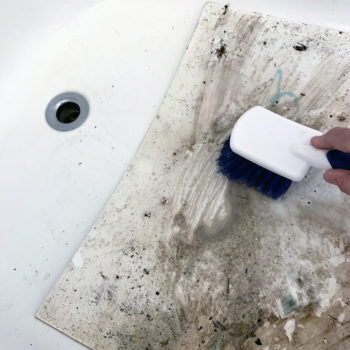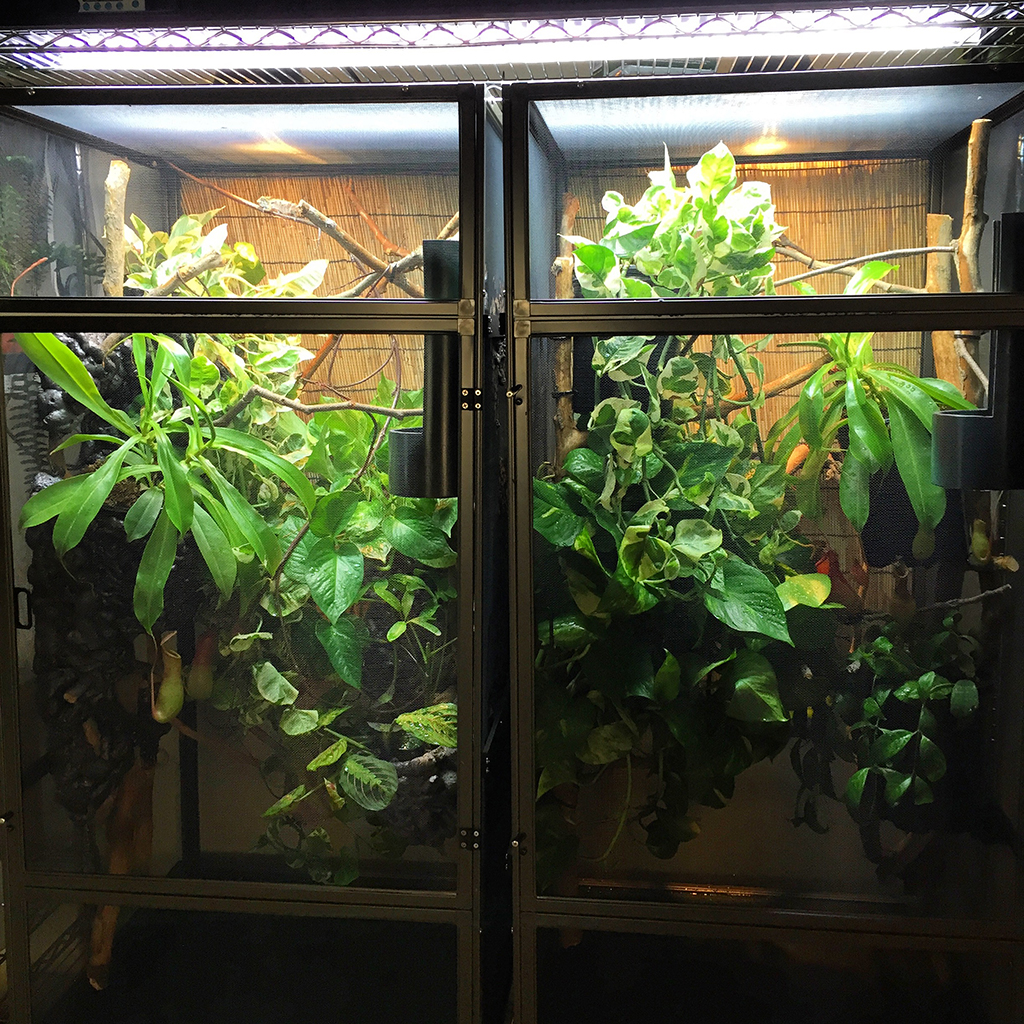Summary: Cleaning Your Chameleon Cage
Having a clean environment is a critical component to chameleon husbandry. In this module we will review different cleaning strategies and the most effective disinfectants available to us hobbyists.
This section is strongly based on an interview I had with Dr. Rob Coke of the San Antonio Zoo who spoke with me about the topic of keeping our chameleon environments clean. I strongly encourage you to listen to the full podcast episode!
Chameleon Cage Spot Cleaning
Spot cleaning is the name we give to simple maintenance chores we perform on a daily basis that usually don’t take more than a minute. Removing biological waste quickly keeps it from spreading. There are some parasites that continue to grow once they are expelled and become infective 24 to 72 hours later. By regular cleaning you disrupt their lifecycle with simple mechanical removal.
The most basic approach is to have a roll of paper towels by the cage and everytime you see a poop you simply pick it up. There is still residue left behind, but the majority has been removed. The residue may be removed by simple soap and water, swipe of a Lysol wipe, or a paper towel sprayed with a disinfectant. In all of these cases be cognizant of the chameleon in the cage and make sure there is not so much disinfectant that the fumes are overpowering.
Spot cleaning is a little more tricky when it comes to poop on leaves. We can try to reduce the number of plants that are below the perching branches, but this rarely is possible when making a naturalistic vivarium. The complication is that chameleons will drink directly off the leaf surface. Hopefully, the leaves the chameleon poops on are far below and in a place where the chameleon does not think to go and drink, but a chameleon cannot be counted on to make this happen for you. If you have to clean poop of the leaves then you can do mechanical removal with the paper towel and then a mild soapy solution to clean the leaf off. Though, if the chameleon has a known parasite problem I often just clip the leaf and dispose of it.
Chameleon Cage Deep Clean
Every weekend it is worth doing a deep clean of at least the floor panel. For this I wipe down the floor panel while it is still in the cage with paper towels so I get most of the biological waste picked up to avoid having poop or soiled water flicked or splashed around as I remove the floor panel. I want anything not stuck on to be gone. I then move the floor panel to the bath tub and come back to clean off the lower part of the cage.
Drainage Tray: To clean the drainage tray, suck all the water out from the middle of the tray by sticking a wet/dry vac in through the service door. Suck up all the water. The drainage tray can then either be cleaned where it sits or you can elect to lift the cage off the tray and then do the same cleaning and disinfecting you are doing to the floor panel.
Lower Cage Frame: The frame where the floor panel rests is a prime location for bacteria and pathogens to take hold as it is relatively dark and can be wet. Generously wipe down this area with disinfectant. If the chameleon is not in the cage you can let the disinfectant sit for a couple minutes. The instructions on your disinfectant will let you know the proper way to get full benefit from their product. Once cleaned, rinse well.
Extra Floor Panel: Having an extra floor panel around can be a great help if you do not have a temporary cage for your chameleon to sit in while you do your cleaning. Once you have completed the lower cage frame you can put in the backup floor piece and continue your deep cleaning without worrying about how much time you are taking. Many Dragon Strand cages have both a screen floor panel and and a plastic floor panel so one can be used as the back-up.
At this point you can go back to the bath tub and deep clean the floor panel. Disinfectants are most effective when you can let them sit for a little while (see instructions on your disinfectant). Clean both sides and rinse well. Screen floors can be cleaned just like the plastic floor.

To begin a deep clean I use a paper towel to brush as much off the floor panel as possible to make the cleaning easier.

Step two is to use dishwashing soap and a brush to do the second round. This will use soapy water to help break up the biological manner so it hcan be removed by the brushing action.

This is where the good old muscle comes in and the floor panel gets a serious scrubbing. The purpose of this stage is to get as much of the biological matter broken off the floor and rinsed away.

Following the overall scrubbing there are often stains on the floors. Far and away, the best way to remove stains from the PVC floors is a product called the Magic Eraser from Mr. Clean. It truly does an incredible job of removing stains from PVC.

And finally, the disinfecting. Ideally, all biological matter has been swept away. But if there is any residue, the disinfectant will take care of anything left. I leave the disinfectant on for the amount of time specified on the bottle. I then rinse with water and dry to ensure there are no fumes left.

Before putting the floor panel back in, take a look at the bottom frame and give that a cleaning. Most of the time the bottom frame does not have worms wriggling around, but this is a more entertaining picture than just some dirty aluminum frames. I had slipped and spilled a cup of Black Soldier Fly Larva in this cage. So there was an a more interesting mess to clean up than normal. Believe me, when you have to create a webpage on cleaning a chameleon cage you jump at the opportunities to have something interesting to photograph.
Effective Chameleon Cage Cleaners
There are a wide variety of cleaners that can be used with chameleon cages. The very top level are listed here. The podcast episode above will discuss the various types if you desire further learning.
Paper towel: Removing biological waste as quick as possible is 90% of the cleanliness mission.
Soap & Water: The most basic dish soap is the first line of defense. Soap and water will provide the initial break down and mechanical removal of large clumps of waste. This is important because our disinfectants cannot disinfect what they cannot touch. Killing the surface bacteria of a clump of poop doesn’t touch the inside. By using soap and water to remove the large parts, the disinfectants can do their job.
Lysol Wipes: A Lysol wipe can provide the same function as a paper towel and soap and water combined. Beware of fumes, though, and rinse well.
Clorox Broad Spectrum Quaternary Disinfectant: This will be our heavy hitter we use for deep cleans. Allowing this to sit on a surface for 2 minutes after the soap & water stage will kill a wide range of pathogens.
As said before, there are many disinfectants and antiseptics used in the reptile industry. I have reduced the list here to a simple and effective list.
Spiders
Spiders are a constant threat as they go where the food is. And you keep the chameleon cage stocked with food on a constant basis. Spiders are mostly a problem when baby chameleons are involved. This is when the food items are most the size that spiders look for and baby chameleons can actually be caught by spiders. If you see a web, but no spider then try coming in at night and see if the spider is out. Spiders become an issue in elaborate naturalistic environments where there are many places to hide that are not easily accessible by you.
Preparing a Chameleon Cage For Another Chameleon
If you are reusing a cage for a new chameleon then it is worthwhile to carefully take the cage apart and do a careful cleaning of each and every piece. There are many nooks where bacteria and parasites can be stored in and you don’t want to bring that in with your new chameleon. Be generous with the soap, water, and Quaternary disinfectant with ample rinsing (after the minimum 2 minute soak) and sun exposure for drying. As far as sun exposure, be careful what you put out. Aluminum framing does great being sun dried, but plastics, especially black plastics, can warp.
Navigation
This seminar is part of the introductory course Maintaining Your Chameleon Cage which, in turn, is a module within the even larger Term 1: Getting Started With Chameleons. Here we got ready to keep not only the chameleon, the entire environment. In the next module, we will look at maintaining the hydration system.



